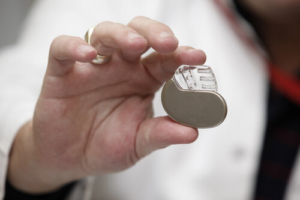Understanding Paroxysmal Atrial Fibrillation: Causes, Symptoms and Treatment
Picture this: You’re sitting at your desk typing away at an important report when suddenly you feel your heart racing. It feels like it’s skipping beats, and you struggle to catch your breath. This is what it’s like to experience paroxysmal atrial fibrillation (AFib), a type of irregular heart rhythm that comes and goes, increasing the risk of stroke and heart-related complications. In this blog post, I’ll dive into the causes, symptoms, and treatment options for paroxysmal atrial fibrillation, empowering you with the knowledge to better understand and manage this condition.
Short Summary
-
Paroxysmal Atrial Fibrillation is a recurrent irregular heart rhythm affecting millions of people globally.
-
It can be treated with medications, catheter ablation and lifestyle modifications to reduce the risk of stroke and improve symptoms.
-
Living successfully with paroxysmal atrial fibrillation requires making lifestyle adjustments, managing symptoms and regular treatment and follow up with healthcare providers.
Defining Paroxysmal Atrial Fibrillation
Paroxysmal atrial fibrillation is a recurrent irregular heart rhythm that affects millions of people worldwide, with an estimated 33.5 million individuals having AFib globally. The most serious complications of AFib are stroke and systemic embolism, with individuals with AFib being 4 to 5 times more likely to have a stroke than those without it.
Characteristics of Paroxysmal AFib
Paroxysmal AFib is characterized by episodes of irregular heartbeats that start and stop on their own, usually lasting less than a week. Treatment for this condition often includes anticoagulant medications to prevent blood clots and reduce the risk of stroke.
Types of Atrial Fibrillation
Atrial fibrillation can be classified into paroxysmal, persistent, and permanent, depending on the duration and severity of symptoms. Structural heart abnormalities, such as coronary artery disease or heart valve problems, can increase the risk of developing atrial fibrillation.
Paroxysmal atrial fibrillation is defined by episodes of irregular heartbeats that last for a few minutes or hours, with common symptoms including heart palpitations, shortness of breath, and fatigue.
It is important to note that if paroxysmal AFib is left untreated, it will usually progress to more severe forms of the condition, such as persistent atrial fibrillation. In general, the frequency, severity, and duration of the episodes of paroxysmal AFIb will continue if you do not seek out medical assistance. Diagnosing paroxysmal atrial fibrillation as early as possible gives patients the best possible chance to reduce or reverse their symptoms.
Identifying Symptoms of Paroxysmal Atrial Fibrillation
The symptoms experienced during an episode of paroxysmal AFib are similar to the symptoms of regular atrial fibrillation. Knowing how to identify and treat these symptoms is essential to keeping yourself and your family members healthy and safe. Some of the most common symptoms of paroxysmal AFib include:
● Elevated resting heart rate
● Chest pain or pressure
● Fatigue
● Feeling dizzy or lightheaded
● Shortness of breath
● Heart palpitations
If you experience these symptoms (even for a short period of time), I highly recommend seeking medical attention to be assessed for possible AFib.
Recognizing Silent AFib
Silent AFib refers to cases where the patient experiences no noticeable symptoms, making it difficult to diagnose without proper testing. Silent atrial fibrillation may be identified incidentally during regular examinations or by chance. It is associated with comparable morbidity and mortality rates as symptomatic AF and can remain undetected for years, raising the risk of complications.
Medications, catheter ablation, lifestyle modifications, and preventive measures are all potential treatment options for silent AFib, similar to other types of AFib.
Causes of Paroxysmal Atrial Fibrillation
The most common causes for paroxysmal atrial fibrillation are similar to other stages of atrial fibrillation. Some of the most common underlying causes for paroxysmal AFib include:
● Advanced age
● Obesity or Elevated body mass index (BMI)
● A history of high blood pressure or other cardiac issues
● Diabetes
● A History of a previous heart attack
And while these conditions may be the underlying cause of a patient’s AFib, they are not always the cause of a specific episode. Trigger events are defined as situations or events that can cause a person to enter into an episode of paroxysmal AFib. Examples of AFib triggers include:
● Fatigue
● Infections and illnesses
● Sleep deprivation
● Dehydration
● Consuming alcohol
Diagnosis and Monitoring
Diagnosis of paroxysmal atrial fibrillation involves a combination of physical examination, medical history, and diagnostic tests, such as electrocardiograms (ECGs). An atrial fibrillation diagnosis is based on characteristic ECG findings indicative of AFib, which include:
-
Lack of distinct “P” waves
-
Irregularly irregular R-R interval
-
Narrow QRS complex tachycardia with a heart rate typically between 110 and 160
-
Fibrillatory waves may be present.
Continued monitoring of AFib patients is essential to monitor the evolution of the condition and adapt treatment plans as needed. Noninvasive methods of ongoing monitoring for paroxysmal atrial fibrillation include prolonged ambulatory monitoring with continuous 7-day ECG monitoring or intermittent monitoring over a period of several weeks. Invasive methods include long-term continuous electrocardiographic monitoring with insertable cardiac monitors.
Diagnostic Tests
Diagnostic tests for AFib can include ECGs, Holter monitors, and event recorders to detect irregular heart rhythms. An electrocardiogram (ECG) is a diagnostic test that records the electrical activity of the heart, and it can be used to detect abnormal heart rhythms, including atrial fibrillation.
A Holter monitor is a device that records an individual’s heart’s electrical activity for a period of 24 to 72 hours, which is utilized to identify abnormal heart rhythms, such as paroxysmal atrial fibrillation. A 72-hour Holter monitoring assessment can improve the rate of detection of silent paroxysmal Atrial Fibrillation (AFib).
Event recorders are small, portable devices that can be worn for up to 30 days, recording the electrical activity of the heart and assisting in the identification of abnormal heart rhythms, such as atrial fibrillation.
Ongoing Monitoring
It is important for patients with atrial fibrillation to maintain regular follow-up appointments with their healthcare provider to track the progression of their condition and adjust treatment plans accordingly. Regular monitoring can help ensure that any changes in the patient’s condition are addressed promptly and that the most appropriate treatment options are being utilized.
By attending regular follow-up appointments, patients can ensure that their condition is being managed effectively.
At Home Monitoring of Atrial Fibrillation
In addition there are several excellent at home tools that are designed for at home monitoring of atrial fibrillation, including the KardiaMobile devices and the Apple Watch.
Treatment Options for Paroxysmal Atrial Fibrillation
Treatment options for paroxysmal atrial fibrillation include medications to control heart rate and rhythm, as well as procedures like catheter ablation to restore normal heart function. Anti-arrhythmic drugs, beta-blockers, and calcium channel blockers are commonly prescribed medications to treat AFib. The primary objectives of AFib treatment are to manage heart rate and rhythm, restore normal heart function, and decrease the risk of stroke.
Catheter ablation is a minimally invasive procedure that targets and destroys the abnormal heart tissue causing AFib, offering a significant improvement for many patients.
Medications
Medications for AFib include anticoagulants, which are commonly prescribed blood thinners used to prevent blood clots and reduce the risk of stroke in individuals with atrial fibrillation. Beta-blockers and calcium channel blockers are utilized to regulate heart rate. It is important to be aware of the potential side effects of medications used to treat AFib, which may include worsening arrhythmia, potential impacts on the lungs, liver or other organs, bleeding, indigestion or even a heart attack.
Catheter Ablation
Catheter ablation is a promising treatment option for many patients with paroxysmal atrial fibrillation. It targets and destroys the abnormal heart tissue responsible for the condition. The procedure involves:
-
Inserting thin wires called catheters into the femoral vein in the groin area.
-
Guiding the catheters to the heart.
-
Using heated or freezing electrodes on the ends of the wires to create strategic scarring in the problematic area.
-
This scarring blocks the heart’s electrical current from reaching areas of the heart muscle that it would not normally reach, preventing irregular or erratic heartbeats.
Typically, individuals can expect the following after a catheter ablation procedure:
-
Discharge on the same day, though some may require an overnight stay
-
Promising results in some patients, offering potential relief from symptoms with less medications.
Lifestyle Changes and Prevention Strategies
Lifestyle changes and prevention strategies for paroxysmal atrial fibrillation include adopting a heart-healthy diet, engaging in regular exercise, and managing stress levels. Making healthy choices can help protect the heart and may prevent the occurrence of Afib.
Research indicates that the following lifestyle changes can be beneficial in mitigating the risk of developing paroxysmal AFib, and improving symptoms.
-
Quitting smoking
-
Abstaining from excessive alcohol consumption
-
Adhering to a healthy and balanced diet
-
Achieving a healthy body weight if overweight or obese
-
Managing stress
Diet and Exercise
A balanced diet and regular physical activity can help reduce the risk of AFib and improve overall heart health. Here are some dietary recommendations for preventing paroxysmal atrial fibrillation.
-
Consumption of fruits, vegetables, and whole grains
-
Selecting low-fat or fat-free dairy products
-
Opting for lean proteins
-
Abstaining from caffeine, alcohol, red meat, processed foods, sugary foods and drinks, and excessive salt intake
Following these recommendations can be beneficial for preventing paroxysmal atrial fibrillation.
Engaging in regular physical activity can also help reduce the risk of paroxysmal atrial fibrillation and improve overall cardiovascular health.
Stress Management
Stress management techniques, such as meditation and deep breathing exercises, can help alleviate AFib symptoms and promote overall well-being. Practicing yoga and other stress-relieving exercises can be beneficial in reducing the risk of paroxysmal atrial fibrillation.
In addition to getting adequate sleep, engaging in regular physical activity, and avoiding stimulants and intoxicants, there are other options for managing stress. These include cognitive-behavioral therapy, mindfulness-based stress reduction, and biofeedback.
Living with Paroxysmal Atrial Fibrillation
Living with paroxysmal atrial fibrillation involves adapting to lifestyle changes, managing symptoms, and maintaining open communication with healthcare providers. Medical alert devices can provide a potentially lifesaving resource for AFib patients who live alone or spend a substantial amount of time alone, as they can summon assistance in medical emergencies.
It is important to bring a list of current medications to healthcare provider appointments to ensure the most appropriate treatment options are being utilized.
Traveling with AFib
Traveling with AFib is possible with proper planning and consultation with a healthcare provider. Here are some tips to consider.
-
Ensure you have an adequate supply of medication for the duration of your trip.
-
Research and identify medical facilities at your destination in case you need medical care.
-
Notify security personnel about any implanted devices, such as pacemakers, to prevent interference from metal detectors.
-
If recommended by your doctor, wear compression stockings during the flight to reduce the risk of blood clots.
-
Try to maintain a healthy diet, avoid excessive alcohol, and maintain hydration.
By following these tips and taking necessary precautions, you can travel with AFib safely.
Schedule regular breaks during extended trips to stretch your legs and avoid prolonged sitting, and bring your medications and any necessary medical documents with you in case of an emergency.
Balancing Work and AFib
Balancing work and AFib may require adjustments to work schedules, stress management techniques, and open communication with employers about the condition. Individuals with autism may need to modify their work schedules to accommodate their condition, such as incorporating breaks throughout the day, decreasing hours, or altering shifts.
Stress management techniques, such as relaxation exercises, mindfulness, and cognitive behavioral therapy, can be employed to help individuals with AFib manage their condition.
Maintaining open communication with employers is of paramount importance for individuals with autism, enabling them to articulate their condition and any adjustments they may require in order to successfully manage their condition while continuing to work.
Summary
In this blog post, we have explored the causes, symptoms, and treatment options for paroxysmal atrial fibrillation. From understanding the different types of atrial fibrillation to the importance of ongoing monitoring, we’ve provided a comprehensive overview of this complex condition. Lifestyle changes and prevention strategies, such as adopting a heart-healthy diet, engaging in regular exercise, and managing stress levels, can help manage symptoms and reduce the risk of complications.
Navigating life with paroxysmal atrial fibrillation may be challenging, but with the right information, treatment plan, and support from healthcare providers, individuals with AFib can lead fulfilling lives. By staying informed and proactive in managing your condition, you can take control of your heart health and reduce the risk of serious complications.
Frequently Asked Questions
How Serious is Paroxysmal Atrial Fibrillation?
Paroxysmal atrial fibrillation can be serious, as it increases the risk of stroke by fivefold and may lead to heart failure.
It is important to recognize the signs and symptoms of paroxysmal atrial fibrillation, which include palpitations, chest pain, shortness of breath, and dizziness. Treatment options include medications, lifestyle changes, and more.
What Is The Difference Between Paroxysmal Atrial Fibrillation and Atrial Fibrillation?
Atrial fibrillation is a disease that occurs in stages. Paroxysmal AFib is one of the early stages of the disease. While atrial fibrillation is the blanket term for all subtypes of the condition, paroxysmal AFib refers to the specific stage of the condition where episodes and symptoms come and go. If left untreated, it can advance to more severe forms of the condition.
What Triggers Paroxysmal Atrial Fibrillation?
Paroxysmal atrial fibrillation (AFib) can be triggered by various factors, including stress, fatigue, caffeine, alcohol, smoking, certain medications, underlying medical conditions (e.g., high blood pressure, thyroid issues), and stimulants like cold or cough medications. Additionally, other triggers may include viral infections, excessive physical activity, and changes in the autonomic nervous system. Identifying and managing these triggers can play a crucial role in reducing the frequency and severity of paroxysmal AFib episodes. It is essential for individuals with AFib to work with their healthcare providers to identify their specific triggers and develop a personalized treatment plan to minimize the impact of these triggers on their heart health.
Does Paroxysmal AFib Need to be Treated?
Yes, paroxysmal atrial fibrillation (AFib) should be treated, even though it may come and go on its own. Paroxysmal AFib episodes can be unpredictable and may vary in frequency and duration. While some individuals may have infrequent and short-lasting episodes, others may experience more frequent and prolonged episodes, which can significantly impact their quality of life and increase the risk of complications, such as blood clots and stroke. Treating paroxysmal AFib is essential to manage symptoms, reduce the risk of complications, and improve overall heart health. Treatment options may include medications to control heart rhythm and rate, anticoagulants to prevent blood clots, lifestyle modifications, and in some cases, procedures like catheter ablation to restore a normal heart rhythm. It is crucial for individuals with paroxysmal AFib to work closely with their healthcare providers to determine the most appropriate treatment plan based on their specific needs and medical history.
Can Paroxysmal Atrial Fibrillation be Cured?
While there is no guaranteed cure for paroxysmal atrial fibrillation, treatments such as catheter ablation have shown promising results and offer potential relief from symptoms.
Catheter ablation is a minimally invasive procedure that involves inserting a catheter into the heart to identify and destroy the abnormal electrical pathways that cause the arrhythmia. This procedure has been found to be effective in reducing symptoms and improving quality of life for many patients.
Does Paroxysmal Atrial Fibrillation Go Away?
By definition, paroxysmal atrial fibrillation episodes last less than seven days and are able to stop on their own. It is common for most episodes to last less than 48 hours. However, just because paroxysmal AFib symptoms do resolve themselves, it does not mean that you should ignore them. The natural progression of atrial fibrillation will result in episodes becoming more severe and more frequent if nothing is done. Seeking out proper treatment is the best way to slow or even reverse the progression of the disease.
How Long Can a Person Stay in AFib?
The duration of atrial fibrillation (AFib) can vary significantly from person to person. Some individuals may experience short episodes that last for a few minutes or hours and spontaneously convert back to a normal heart rhythm (sinus rhythm). Others may have persistent AFib, which lasts for more than seven days, and requires medical intervention to restore a regular rhythm. Additionally, some individuals may have permanent AFib, where the condition does not convert back to sinus rhythm, even with treatment attempts. The duration of AFib can also be affected by various factors, including the underlying cause, the presence of other medical conditions, and the effectiveness of the chosen treatment plan. For an accurate understanding of an individual’s AFib duration and appropriate management, it is essential to consult with a healthcare professional.
The Best Atrial Fibrillation Book
Your Complete Guide To AFib: The Essential Manual For Every Patient With Atrial Fibrillation
$15.95 (as of April 24, 2024 10:30 GMT -06:00 - More infoProduct prices and availability are accurate as of the date/time indicated and are subject to change. Any price and availability information displayed on [relevant Amazon Site(s), as applicable] at the time of purchase will apply to the purchase of this product.) The A to Z guide on everything you need to know about atrial fibrillation. Written by AFib expert Dr. Percy Morales MD. Over 120 pages of essential information on medications, procedures, and lifestyles modifications for AFib. Easy to read for every patient.
Shop AFib Products on Amazon
KardiaMobile 6-Lead Personal EKG Monitor – Six Views of The Heart – Detects AFib and Irregular Arrhythmias – Instant Results in 30 Seconds – Works with Most Smartphones - FSA/HSA Eligible

KardiaMobile 1-Lead Personal EKG Monitor – Record EKGs at Home – Detects AFib and Irregular Arrhythmias – Instant Results in 30 Seconds – Easy to Use – Works with Most Smartphones - FSA/HSA Eligible

Apple Watch Series 9 [GPS 41mm] Smartwatch with Storm Blue Aluminum Case with Silver Sport Band M/L. Fitness Tracker, Blood Oxygen & ECG Apps, Always-On Retina Display

Fitbit Sense 2 Advanced Health and Fitness Smartwatch with Tools to Manage Stress and Sleep, ECG App, SpO2, 24/7 Heart Rate and GPS, Shadow Grey/Graphite, One Size (S & L Bands Included)

OMRON - Complete Wireless Upper Arm Blood Pressure Monitor + EKG - Built-in Bluetooth Technology

Omron Hem 7361T Bluetooth Digital Blood Pressure Monitor with Afib Indicator and 360° Accuracy Intelliwrap Cuff for Most Accurate Measurements (White)

EMAY Portable ECG Monitor | Record ECG and Heart Rate Anytime Anywhere | Stand-Alone Device with LCD Screen and Storage | No Subscription Required

Samsung Galaxy Watch 6 44mm Smartwatch with HR Zones, Sleep Coaching, Heart Monitor - Graphite

Natural Rhythm Triple Calm Magnesium 150 mg - 120 Capsules – Magnesium Complex Compound Supplement with Magnesium Glycinate, Malate, and Taurate. Calming Blend for Promoting Rest and Relaxation.

Pure Encapsulations Magnesium (Glycinate) - Supplement to Support Stress Relief, Sleep, Heart Health, Nerves, Muscles, and Metabolism* - with Magnesium Glycinate - 180 Capsules


















![Apple Watch Series 9 [GPS 41mm] Smartwatch with Storm Blue Aluminum Case with Silver Sport Band M/L. Fitness Tracker, Blood Oxygen & ECG Apps, Always-On Retina Display #1](https://m.media-amazon.com/images/I/311xwtp4mFL._SL100_.jpg)
![Apple Watch Series 9 [GPS 41mm] Smartwatch with Storm Blue Aluminum Case with Silver Sport Band M/L. Fitness Tracker, Blood Oxygen & ECG Apps, Always-On Retina Display #2](https://m.media-amazon.com/images/I/41j+8AaUGsL._SL100_.jpg)
![Apple Watch Series 9 [GPS 41mm] Smartwatch with Storm Blue Aluminum Case with Silver Sport Band M/L. Fitness Tracker, Blood Oxygen & ECG Apps, Always-On Retina Display #3](https://m.media-amazon.com/images/I/41jIyxZitnL._SL100_.jpg)
![Apple Watch Series 9 [GPS 41mm] Smartwatch with Storm Blue Aluminum Case with Silver Sport Band M/L. Fitness Tracker, Blood Oxygen & ECG Apps, Always-On Retina Display #4](https://m.media-amazon.com/images/I/41IpNJERjCL._SL100_.jpg)
![Apple Watch Series 9 [GPS 41mm] Smartwatch with Storm Blue Aluminum Case with Silver Sport Band M/L. Fitness Tracker, Blood Oxygen & ECG Apps, Always-On Retina Display #5](https://m.media-amazon.com/images/I/31o17yhfYpL._SL100_.jpg)

















































